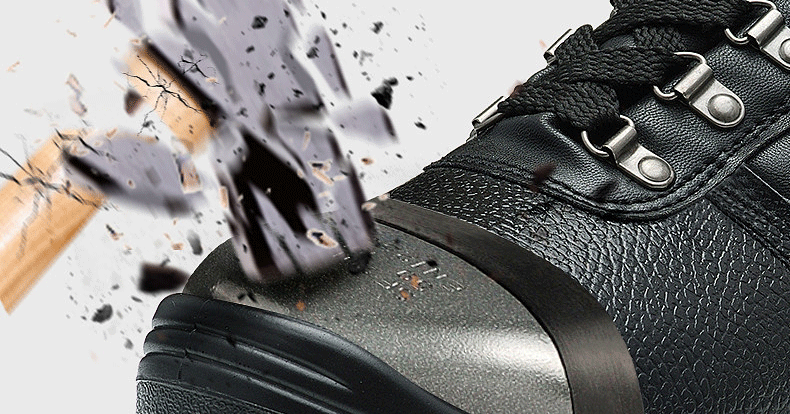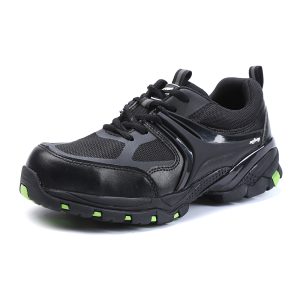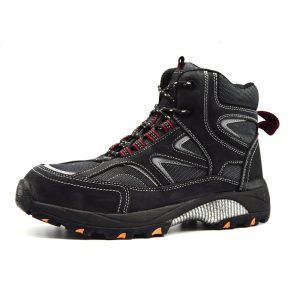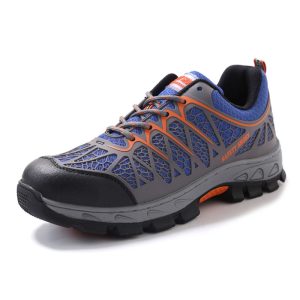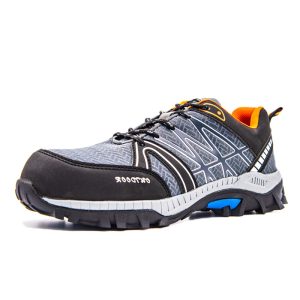Anti-smashing safety shoes are a type of personal protective equipment specially designed and manufactured to protect the feet of workers in hazardous working environments. They have anti-pressure and anti-smashing functions, which can reduce or prevent damage to the feet from falling objects, the pressure of heavy objects or other external forces. Anti-smashing safety shoes are widely used in construction, factories, logistics, mining and other industries to provide workers with the necessary protection.
The characteristics and protective functions of anti-smashing safety shoes
Protective material: Smash-resistant safety shoes are usually made of high-strength materials, such as steel toe, aluminum toe or composite materials. These materials are effective against external impacts, protecting the foot from pressure and pinching.
Puncture resistance: In addition to protecting the head, the anti-smashing safety shoes also have a puncture resistance function to prevent sharp objects from penetrating the soles and causing damage to the feet. The soles are generally made of high-strength materials such as steel plates or Kevlar, which can effectively block the penetration of sharp objects.
Anti-slip performance: Anti-smashing safety shoes usually have good anti-slip function, provide better stability and adhesion in wet or greasy working environments, and reduce the risk of slipping and falling.
Comfort design: In order to provide a better wearing experience, the anti-smashing safety shoes are designed with comfort factors in mind. The breathable, moisture-wicking lining material is used to keep the inside of the shoe dry and comfortable; the reasonable shoe structure and cushioning function reduce the fatigue caused by long-term wearing.
Application fields of anti-smashing safety shoes
Construction industry: On construction sites, there is a risk of foot injuries from falling objects, masonry fragments, steel bars, etc. Anti-smashing safety shoes can protect workers’ feet when working at heights or in dangerous areas.
Factory manufacturing: On the production line of a factory, common work scenarios include heavy object handling, mechanical operation, etc., and there are dangers such as heavy object rolling and impact. Anti-smashing safety shoes can effectively reduce the damage of these external forces to the feet.
Logistics industry: goods are frequently moved in logistics warehouses, and there is a risk of heavy objects stepping on or crushing feet. Anti-smashing safety shoes can provide sufficient protection for logistics workers and reduce the incidence of accidental injuries.
Mining industry: When mining workers are digging underground or in the open pit, there is a threat of crushing their feet due to rock collapse and rolling of rocks. Anti-smashing safety shoes can mitigate these hazards on workers’ feet.
Factors to consider when purchasing anti-smashing safety shoes
Suitable for the working environment: Choose suitable anti-smashing safety shoes according to the characteristics of the working environment, including protection level, anti-skid performance, anti-puncture ability, etc.
Appropriate size: Make sure that the size of the anti-smashing safety shoes you choose matches your own foot shape, so as to avoid discomfort caused by too large or too small size or affect the protective effect.
Product quality: Choose a well-known and reputable brand to ensure that the anti-smashing safety shoes meet relevant standards and quality requirements.
Comfort and durability: Pay attention to the comfort and durability of your smash-resistant safety shoes, and choose products that can be worn for extended periods of time without causing discomfort or damage.
The standards of anti-smashing safety shoes mainly include international standards and national standards. The following are some common standards for anti-smashing safety shoes:
International standard:
EN ISO 20345: This is the European standard that specifies various requirements and test methods for smash-resistant safety shoes. This standard divides anti-smashing safety shoes into different protection levels, such as SB, S1, S2, and S3 levels, which correspond to different protection functions and performance requirements.
National standard:
GB 21148-2007: This is the national standard of China, which specifies the design, performance and test methods of anti-smashing safety shoes.
GB/T 23422-2009: This is the national standard of China, which specifies the design, performance and test methods of puncture-resistant safety shoes.
When choosing anti-smashing safety shoes, you can consider the following aspects:
Work Environment and Risk Assessment: Understand the work environment and identify potential risks and hazards such as falling objects, weight pressure, puncture risk, etc.
Protection level: According to the needs of the working environment, choose anti-smashing safety shoes that meet relevant standards. Different grades of safety shoes have different protective functions, and you can choose the appropriate grade according to your needs.
Comfort and fit: Choose a smash-resistant safety shoe that suits your foot shape to ensure comfort and fit. There are several brands and models to try on, taking care to choose the right shoe size.
Material and quality: Pay attention to the material and quality of the anti-smashing safety shoes to ensure that they comply with relevant standards and regulations. Choose brands and products with a good reputation and reliable quality.
Anti-slip performance: According to the characteristics of the working environment (such as wet or greasy ground), choose anti-smashing safety shoes with good anti-slip performance to reduce the risk of slipping and falling.
Abrasion resistance and durability: Consider the abrasion resistance and durability of smash-resistant safety shoes, and choose products that can withstand the vigorous use in the work environment.
When choosing anti-smashing safety shoes, you can refer to the above standards and selection factors, and make appropriate decisions according to your own needs and the characteristics of the working environment. It is recommended to consult professionals or refer to the recommendations of protective equipment suppliers to ensure that the selected anti-smashing safety shoes can provide sufficient foot protection and safety performance.




